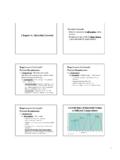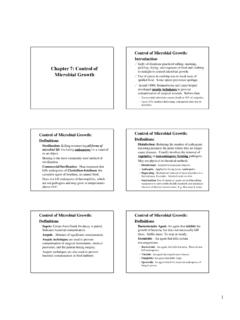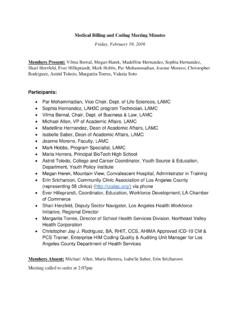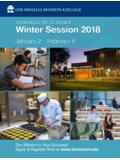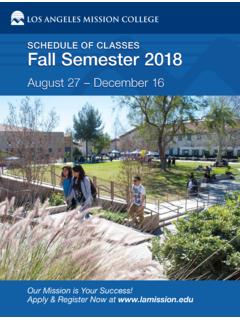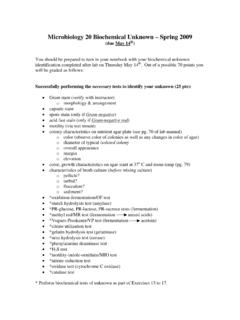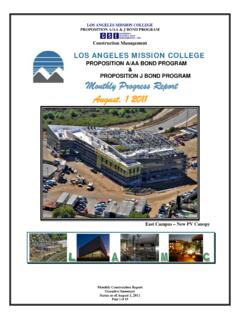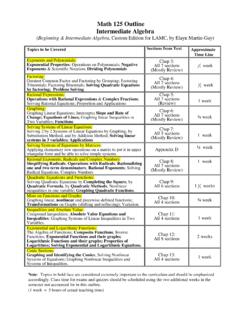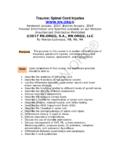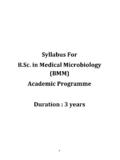Transcription of Chap 6 Reflexes - Los Angeles Mission College
1 Reflex Physiology 2009 EbneshahidiDr. Ali Ebneshahidi Reflexes are automatic, subconscious response to changes withinor outside the body. a. Reflexes maintain homeostasis (autonomic Reflexes ) heartrate, breathing rate, blood pressure, and digestion. b. Reflexes also carry out the automatic action of swallowing,sneezing, coughing, and Physiology 2009 Ebneshahidisneezing, coughing, and vomiting. c. Reflexes maintain balance & Spinal Reflexes control trunk and limb muscles. d. Brain Reflexes involve reflex center in brain Reflexes for eye ,includingafewneurons, Arc 2009 Ebneshahidi detects the ) Description: the receptor end of a particular dendrite or aspecialized receptor cell in a sensory ) function: sensitive to a specific type of internal or of Reflex Arc 2009 Ebneshahidi neuron conveys the sensory info. to brain or Description: Dendrite, cell body, and axon of a sensory Function: transmit nerve impulses from the receptor into thebrain or spinal cord.
2 : relay Description: dendrite, cell body, and axon of a neuron withinthe brain or spinal function: serves as processing center, conducts nerve impulsesfrom the sensory neuron to a motor Arc 2009 Ebneshahidi neuron: conduct motor output to the Description: Dendrite, cell body, and axon of a motor function: transmits nerve impulse from the brain or spinal cordout to an Arc :a. Description: a muscle or function: Response to stimulation by the motor neuron andproduces the reflex or behavioral action. 2009 EbneshahidiStretch and Deep Tendon Reflexes For skeletal muscles to perform normally: The Golgi tendon organs (proprioceptors) mustconstantly inform the brain as to the state of the 2009 Ebneshahidiconstantly inform the brain as to the state of themuscle. Stretch Reflexes initiated by muscle spindles mustmaintain healthy muscle Spindles Are composed of a few intrafusal muscle fibers thatlack actin and myosin in their central regions, arenoncontractile, and serve as receptive surfaces.
3 Muscle spindles are wrapped with two types ofafferent endings: primary sensory endings of type Iafibers and secondary sensory endings of type II 2009 Ebneshahidifibers and secondary sensory endings of type IIfibers. These regions are innervated by gamma ( ) efferentfibers. Note: contractile muscle fibers are extrafusal fibersand are innervated by alpha ( ) efferent Spindles 2009 EbneshahidiOperation of the Muscle Spindles Stretching the muscles activates the muscle spindle There is an increased rate of action potential in Iafibers 2009 Ebneshahidi Contracting the muscle reduces tension on themuscle spindle There is a decreased rate of action potential on IafibersOperation of the Muscle Spindles 2009 EbneshahidiStretch Reflex Stretching the muscle activates the muscle spindle Excited motor neurons of the spindle cause thestretched muscle to contract Afferent impulses from the spindle result ininhibition of the antagonist 2009 Ebneshahidiinhibition of the antagonist Example.
4 Patellar reflex Tapping the patellar tendon stretches the quadricepsand starts the reflex action The quadriceps contract and the antagonistichamstrings relaxStretch Reflex 2009 EbneshahidiGolgi Tendon Reflex The opposite of the stretch reflex. Contracting the muscle activates the Golgi tendonorgans. Afferent Golgi tendon neurons are stimulated, 2009 Ebneshahidi Afferent Golgi tendon neurons are stimulated,neurons inhibit the contracting muscle, and theantagonistic muscle is activated. As a result, the contracting muscle relaxes and theantagonist muscle Tendon Reflex 2009 EbneshahidiMuscle spindle & Golgi tendon organ Simplest reflex becauseit has only one synapsein the path of its arc. Muscle spindlescontain the sensoryreceptors for the stretchMonosynaptic Stretch Reflex 2009 Ebneshahidireflex. Each spindle containsmodified muscle fiberscalled spindle orintrafusal fibers (insidespindle), innervated bygamma efferent fibers.
5 The middle segmentof each spindle fiberacts as a mechanicalstretch receptor that isconnected to a sensoryafferent nerve to thespinal cord. 2009 Ebneshahidi Stretching of themuscle stretches thespindle fibersactivating the musclespindle stretchreceptors and theassociated sensoryfibers. The terminals of the spindle sensory fibers make direct excitatorysynaptic contact with alpha motor neurons serving the ordinarymuscle fiber (extrafusal fibers). Contraction of these fibers shorten the muscle and relaxes thespindle fibers terminating the stretch reflex and musclecontraction. 2009 Ebneshahidi 1. Passive stretch of a muscle (produced by tapping its tendon)stretches the spindle (intrafusal) fibers. 2. Stretching of a spindle distorts its central (chain) region, whichstimulates dendritic endings of sensory nerves. 3. Action potentials are conducted by afferent (sensory) fibersinto the spinal cord on the dorsal roots of spinal in monosynaptic stretch reflex-Summary 2009 Ebneshahidi 4.
6 Axons of sensory neurons synapse with dendrites and cellbodies of somatic motor neurons located in the ventral horn graymatter of the spinal cord. 5. Efferent impulses in the axons of somatic motor neurons(which form the ventral roots of the spinal nerves) are conductedto the ordinary (extrafusal) muscle fibers. These neurons are(alpha) motor neurons. ,andthusthewholemuscle. ,thusdecreasingelectricalactivityintheaf ferentnervefibers,andrelaxesthespindlefi berandterminatesthestretchreflexandmuscl econtraction. 2009 :Bysendingcommandtothemotorneurons,thebr ainsetamuscle deep tendon Reflex-Ifyoutaponthetendonofamuscle, 2009 Ebneshahidi-The spindle discharges and excites the associated sensory fibers thatexcite the motor neurons to the extensor of the extensor muscle extends the lower leg (knee-jerk).-Ipsilateral flexor muscle relax for extensors to of the sensory fibers from muscle spindle activate inhibitoryinterneuron, which in turn inhibit the motor neuron to the flexor 2009 Ebneshahidiinterneuron, which in turn inhibit the motor neuron to the flexormuscle.
7 The automatic withdrawal of an extremity from apainful stimulus. A polysynaptic reflex. Sensory pain signals excite motor neurons to theflexor muscles, eliciting flexion and withdrawal ofThe withdrawal reflex (flexor reflex) 2009 Ebneshahidiflexor muscles, eliciting flexion and withdrawal ofthe leg. motor neurons to the extensor muscles are inhibitedvia inhibitory interneurons. This would relax the extensors of the same withdrawal reflex 2009 Ebneshahidi Apolysynapticreflex. (withdrawal)oftheipsilaterallegaswellast heextensionofthecontralateralleg,tostabi lizetheThe crossed extensor reflex : 2009 Ebneshahidiextensionofthecontralateralle g,tostabilizetheposture;thustheipsilater allegflexorsareactivatedandtheextensorsa reinhibitedandviceversainthecontralatera lleg. Biceps jerk reflex: the examiner places finger on the inside of theextended elbow over the tendon of the biceps muscle and thefinger is tapped.
8 The biceps contracts in response, and the forearmflexes at the elbow. Triceps jerk reflex: tapping the short tendon of the triceps muscleclose to its insertion near the tip of the elbow elicit this reflex. theSuperficial Reflexes 2009 Ebneshahidiclose to its insertion near the tip of the elbow elicit this reflex. themuscle contracts in response, and the forearm extends, slightly. Abdominal reflex: the examiner strokes the skin of the abdomenwith a dull pin from the side of abdomen upward towards themidline and above the umbilicus. The umbilicus moves towardsthe stimulated region. Ankle jerk reflex (plantar reflex): tapping theAchilles tendon just above its insertion on theCalcaneous elicits this reflex. The response isplantar flexion, produced by contraction of thegastrocnemius and the solues muscles. 2009 Ebneshahidi Cremastric reflex: this reflex is elicited in males bystroking the upper inside of the thigh.
9 In response,the testis on the same side is elevated by Terms: Analgesia: loss or reduction in the ability to sensepain, without loss of consciousness. Analgesic: pain relieving drug. Anesthesia: loss of feeling. Ataxia: partial or complete inability to coordinate 2009 Ebneshahidi Ataxia: partial or complete inability to coordinatevoluntary movements. Epilepsy: Disorders of the CNS that is characterizedby temporary disturbances in normal brain impulses;it may be accompanied by convulsive seizures andloss of consciousness. Huntington disease:Hereditary disorders of thebrain producing progressively worsening ,uncontrollable dance like movements andpersonality changes. Neuralgia: sharp, recurring pain associated with a 2009 Ebneshahidi Neuralgia: sharp, recurring pain associated with anerve, usually caused by inflammation or injury.
